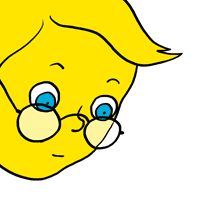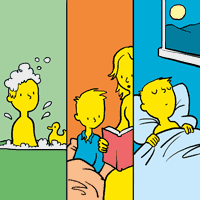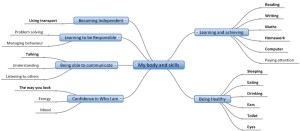Talking Mats is fun! Whether you are sitting on the floor completing your mat or sitting at a small table, young children enjoy the fact that they can give information through multiple channels – Talking Mats is visual, auditory and tactile. It is an engaging tool to use when consulting children.They can express a view without words if they want to or they can have a conversation if they enjoy chatting. Watching a young child thinking and reflecting about where they place their symbol on the mat can be a humbling experience. Some adults still consider young children as incapable of expressing their views or opinions but in reality they can often express strong views about things and are very capable of grading their responses. Sometimes we just don’t take the time to ask them about the issues in their lives and free up some time to listen.
Talking Mats has created a specific Early years resource to make consulting young children easier. The symbols have been graded according to their developmental stage. When using the picture symbols it is important to remember:
- Most of the symbols in the Early years pack are concrete and you can quickly identify the shared meaning for example – “drawing”
- Others are concrete but have a broader meaning. An example of this is when asking about “eyes”
We have found that it is best to allow the child to interpret the meaning at their level so it maybe they have sore eyes; they don’t like their glasses or they have brown eyes. Try not to be too prescriptive when presenting the option to the child; a symbol can act as a jump off point capturing what fits for the child at the time. Just allow the meaning to emerge.
• The abstract symbols do need a bit more explanation because they ask about more complex concepts such as safety. The Early years pack asks about safety in relation to the road, physical safety and safety around others.
Asking about daily routines will give insight into how nurtured and cared for they feel. Let the child lead the discussion as much as possible.
Using visual communication is a great way to have a conversation with children in the early years and a good tool to involve children in decision making. Listening to the child’s view is essential for the GIRFEC process in Scotland and for co-producing Education Health care plans in England and Wales. Talking Mats has created a unique resource which is based on the “International Classification of Functioning, Disability and Health – Children and Youth version” Talking Mats uses a framework which helps children to express themselves in a way they feel comfortable with. As adults we need to be able to facilitate the conversation.
We find that to realize the full potential of Talking Mats it is best to attend a Talking Mats course . The courses allow you to focus on your situation and how you can be creative and apply it in your own work,
The following are thoughts from Jenni, a Psychologist who attended the Talking Mats Accredited training course.
‘Meeting with five colleagues from Sweden, England and various parts of Scotland for the accredited Talking Mats Training this month has been a fascinating experience. I have been accustomed to using Talking Mats with children and young people over the past seven years, and have seen the value of the approach in helping young people give their views for a meeting – particularly if they have communication difficulties and would struggle either through lack of confidence or skill to speak out when others are present.
However, we were not just a group who work with children and young people. Most came from health settings and examples were drawn from elderly patients, some with dementia, others with autism. As we shared our videos and told our stories it was obvious to me how relevant Talking Mats can be in those settings too. Some of the stories shook me. One person told how she was deep in conversation with a lady over her Talking Mat when the tea lady burst in, poured a cup of tea for the resident, asked if she was having a good time playing at puzzles, then left before any answer could be given. Time and again we found ourselves asking what is it about our institutions that puts routines above real communication and above proper respect for an individual.
In preparing a video to bring to the training I undertook a Talking Mat with my father, who is almost 90. It was a new kind of conversation for us both, but we were surprised – the structure allowed us to talk about what was going well and what needed a bit of an adjustment in domestic life and we both learned from the conversation. I think we will do it again!
Indeed, at one stage in the training we were asked to dream big and look at how we might want to take use of Talking Mats into new areas. I identified some good friends – one 91, one 101 and one 104 – where conversation can become rather one-sided. I am interested in the power of Talking Mats to help create a genuine dialogue when these friends are reminiscing, in other words, to help me to be not just a listener but to enter the dialogue. Having a record of the conversation will help us take the discussion further when we return to it.
As ever, the time spent with Talking Mats colleagues was refreshing, stimulating and I can’t wait to go home and try out some new ideas!’
Jenni Barr, Educational Psychologist
We wanted to develop a tool that would give a holistic picture of how a child or young person feels about their lives at home at school and in their communities. We took into account the significant developmental changes that occur from 3 to 17 years and the influence of environmental and personal factors surrounding the child or young person.
We asked our artist to reflect the age and stage of the child in developing a symbol set for:
- Early years
- Primary and
- Secondary
The symbols are organised into three topics:
My Body and Skills: In this section you explore how the child is growing and developing by focussing on the functions of the body as well as skills that are emerging. You can gain an impression of how the child feels he or she is progressing physically, socially, cognitively and behaviourally.
What I do and my support: In this section you look at the child’s lived experience by asking about the activities they participate in, as well as how they feel about the support they receive.
My Wider world: The communities in which children grow up have a significant impact on the well-being of both children and families. In this section you look at the child’s wider world by exploring the impact of nursery or school as well as the support system available to them.
Talking Mats prompts you to cover the relevant topics for each age group you’re working with. You can help children and young people to see their personal strengths and abilities and take time to consider what their problem areas are.
The mind map below shows what is included in the Primary pack – What I do and my support.
If you want to read about how Talking Mats were used to help young people think about targets for their IEP read the 2012 research report.
If you would like the complete Consulting children and young people pack, covering Early years, Primary and Secondary then buy the silver resource which can be purchased either as an original or through a digital subscription.
One of the things I love about Talking Mats is that it can be used by all agencies. When thinking about the rationale behind GIRFEC the main focus is to encourage professionals to work together. It is so refreshing to have a resource that is recognised and used across the agencies.
It is not necessary to have written reports with names of assessments or measures that are a mystery to each other. Talking Mats uses visuals to capture feelings and views. The reporting of those views can be understood by children, parents and professionals.
In developing our new resource we listened and responded to a wide range of professionals. We have researched the Well-being indicators and have provided a tool to give an overview of the issues in the lives of children and young people.
Our vision is to provide a tool to listen to and capture children’s voices. We have a responsibility to be open and realistic about how we respond to what they tell us. Taking time to listen means we need to take time to respond.
We hope that Talking Mats will improve understanding throughout the whole GIRFEC team as we seek to get to the heart of what matters to the child. Margo Mackay
(more…)
Talking Mats role in child protection
Here are 3 stories of how Talking Mats has been helpful to staff from Edinburgh Council – Child Protection Team.
Use with parents
N. works with chaotic drug using parents and said “TMs was a turning point – like gold dust – it helped parents identify important issues”.
Involving child in access decisions
A young girl completed two mats the first one about going to mum’s and the second one about going to dad’s. The social worker was then able to explain to the parents how the child felt and TMs allowed the parents to discuss positive ways to unify care. The visual impact of having two differing viewpoints is very powerful.
Use of Talking Mats in children’s panels
L. has trained many Children’s Panel members in Edinburgh and some are now asking social workers if they have used a TM. Using the actual mat rather than a photo was considered to be more beneficial. “it is like the child is present in the room”. An example was given of a young child bringing in her mats about cats. She showed the panel member her mat and it acted as evidence to show the panel that the girl is now able to separate from her mother. Her mother had suffered abuse as a child and she had become over-protective of her daughter. TM increased the child’s participation.
If anyone has used Talking Mats in Child Protection we would love to hear from you.
The Talking Mats Team have been funded by the Scottish Government to adapt the CARE Measure to make it accessible for children and to examine if the Paediatric CARE Measure (PCM) can be used to gain the views of children or parents attending AHP services. It is a patient-centred measure of relational empathy. It measures patients’ experiences of the interpersonal aspects of clinical encounters. It is recommended that the PCM is used by all Paediatric Allied Health Professions as standard practice. This should be supported by AHP Child Health Leads and will inform the self-assessment component of recommendation 5.6 in the AHP National Delivery Plan and will be integral in the development of the AHP Children’s Services Plan (Recommendation 4.1).
For information about the research project which was carried out to establish the feasibility, reliability and validity of the PCM please click on the following links:
Paediatric CARE Measure – Phase 2 Final Report
Paediatric CARE measure – Phase 2 Summary
For copies of the AHP guidance, PCM forms and information sheets please click below
Involving young people in making decisions that affect their education can be both challenging and time consuming. Margo Mackay has just completed a research project, funded by NHS Forth Valley, which examined whether using the International Classification of Functioning, Disability and Health – Children and Youth Version (ICF-CY) can be usefully combined with Talking Mats to provide a practical framework for decision making and target setting. It tested whether:
- combining Talking Mats and the ICF-CY framework was acceptable to secondary pupils with complex needs, and
- using the information obtained from them is helpful in setting targets for their Individual Education Plans
The project found that Talking Mats, when combined with ICF-CY, is a powerful tool with the potential to greatly enhance the nature of partnerships between pupils, parents and professionals.
At our recent accredited training Anne Lafferty form the Advocacy Project Glasgow described how she used Talking Mats in a group setting. She had been asked to work with a group of adults with mental health difficulties who lived together in a house but found it a challenge to relate to each other. She decided to use Talking Mats with a data projector plus lots of paper and glue . The topic was what activities they were interested in participating in and what Anne did was project each symbol one at a time onto the screen and then everyone placed their own symbol onto their own paper Mat. She said this worked really well, the image of the symbol projected onto the wall held the groups attention but everyone had their chance to express and then share their views. Apparently the staff were amazed and really pleased about how well the tenants participated, stayed and listened to each other. Thought it worth sharing this easy and creative way to use Talking Mats in a group setting – thanks for the idea Anne
 Online training login
Online training login 








